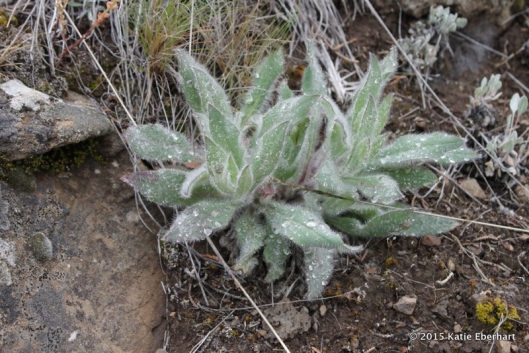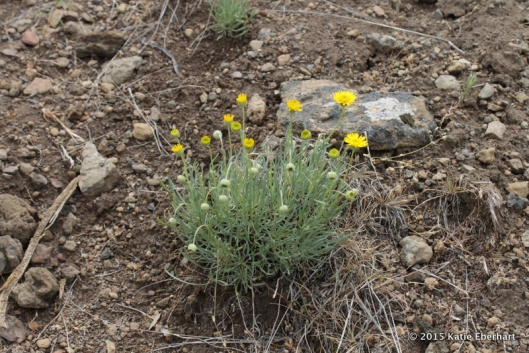Tags
Deschutes Land Trust, Eastern Cascades Slopes & Foothills Ecoregion, Whychus Canyon Preserve, wildflowers
Whychus Canyon Preserve, in central Oregon, is owned by the Deschutes Land Trust and managed for habitat, species diversity, and sustainability. The Preserve is open to the public for hiking, but to learn to recognize, and name, the many wildflowers, it’s best to go on a guided hike. In late May, Jane Meissner, a naturalist and wildflower specialist, led a wildflower hike into Whychus Canyon. I signed up to be the shepherd—the person who hikes at the end of the line to make sure no one gets sidetracked, or left behind.
The day began as overcast and threatening rain. In fact, the weather forecast was for rain and possibly thunderstorms. I stuffed a raincoat into my pack, along with a lunch, hat, binoculars, camera, and a notebook and pen. At the Whychus Canyon trailhead, eight of the twelve people who had signed up for the hike, showed up. After introductions, we started along the fairly flat trail toward the canyon rim. Our progress was slow through the juniper-bitterbrush forest because, every few minutes, we stopped to see another wildflower, some blooming—like False Dandelion, Threadleaf Phacelia, Larkspur, Puccoon, and Lupine—and others only clumps or clusters of leaves—like Hawksbeard and Hawkweed.
After a half mile, and nearly an hour, of stop-and-go walking, we emerged from the trees into a landscape of bunchgrass, bitterbrush, sagebrush, and rabbitbrush. A cemented stone bench marked where the trail turned down into the canyon. Below us, at the bottom of the canyon, brushy-greenery marked the route of Whychus Creek. The line was straighter than you would have seen before the 1960s when the stream was “straightened”. The Land Trust plans to reinstate Whychus Creek into its former meandering channel and recreate habitat more favorable for fish and wildlife, and plant communities.
We started down the steep trail but stopped at the first switchback to look at a clump of Pale Forget-me-not tucked beside a rock outcrop. Jane mentioned that this plant is also called White Stickseed and—like cocklebur—the seeds will cling to mammal fur or a hiker’s socks which is a good ploy for hitchhiking to a new location. Attached to someone’s socks, the seeds may travel long distances very quickly—by auto or even by plane.
After several more switchbacks, the trail leveled and we traversed a slope that was wider and not precipitous like I’d expected. The hillside faced north and the wildflowers were profuse, and diverse.
Viewing wildflowers, you see the effect of time, how a stage of growth, or aging, may happen during just one day, or a few days. We came too late to view the delicate Sand Lily blooms; instead we saw only the plants—ground-hugging rosettes of narrow leaves—scattered across a dry wash.
As we went along, I mentally checked off familiar flowers—the Lupine’s purple spikes; the large-leafed clusters and dramatic yellow blooms of Arrow-leaf Balsamroot; and a red Paintbrush that never fails to remind me of summer weekends during my childhood spent in the mountains.
The trick, though, is to remember plants you see for the first time. I jotted plant names. Sometimes, since I was at the end of the line of hikers, I asked Jane to repeat the name. Sometimes I sketched the shape of a flower, clicked a quick photo, or scribbled comments I hoped would later jog my memory, like:
Thread-leaf Phacelia: one bloom on stunted stalk.
Hawkweed: fuzzy leaves, not blooming. Fuzz collects water droplets.
Prairie Star: Tiny white petals. Saxifrage family.
The sun was breaking through the clouds when we spread out across the rock ledge of an ancient lava flow and unpacked our lunches. After eating, we hiked down a trail that was steeper and, in some places, rocks had been placed to form steps. At the bottom of the canyon, the path leveled out and the walking was easier. Whychus Creek chattered like the Laughing Brook in Thornton Burgess’ Mother West Wind stories. Now and then we had a view of the creek through gaps in the jungly thickets. Jane pointed out Scouring Rush (an equisetum), Star Solomon’s Seal, Chokecherry, and other plants that need a wetter environment than juniper and bitterbrush.
Thunderheads were amassing to the north and west as we climbed a steep track that had once been some sort of access road. The air was muggy and the exertion of climbing made the heat seem even more intense. Out of the canyon, we followed a trail that wound between junipers and bitterbrush but sometimes also crossed open expanses. We stopped to look at a Cushion Fleabane, the clump of small purple flowers all the more fascinating because it was the only plant in a swath of sand.
The clouds thickened and blotted out the sun. We hurried, hardly stopping at all the last mile-and-a-half. With our cars in sight, we were pelted by the first big raindrops.
. . .
Later, reading my notes, I tried to make sense of what I learned on the wildflower hike through Whychus Canyon. I had scribbled the names of fifty-six plants beginning with the tiny white Tidy Tips and ending with White-stemmed Stickleaf. My notes were cryptic though and only conveyed the slightest notion of the canyon landscape.
I think of our group as if we were prospectors or treasure hunters drawn along by the hope of finding another even more spectacular plant. And yet that probably wasn’t the quest at all. To know the wildflowers of a place is like solving a puzzle which might take a long time. For now, I hope to remember the names of at least some of the plants that I saw for the first time this spring at Whychus Canyon.
Twelve Whychus Canyon wildflowers to remember:

1. Puccoon (Lithospermum ruderale). Spiky leaves and unassuming yellow flowers, and a name that rhymes with raccoon, maroon, and balloon.

2. Pale Forget-me-not, also called White Stickseed. Look closely at the white-flowered plant tucked up against the boulders, and notice, like a puzzle, the deeply notched leaves of Hawksbeard (lower right) and the narrow Lupine leaves (lower left).

3. Hawkweed. Not yet blooming. The furred leaves caught the raindrops, as if the water could be saved for a dry spell, or perhaps the droplets serve as a watering hole for birds, reptiles, or the tiniest mammals.

4. Rosy Pussy Toes (Antennaria microphylla/rosea) small pinkish flower clusters that bloom as compactly as the pads on a cat’s paw.

6. Dwarf Monkey Flower—purple (Mimulus nanus) and Small-headed Tarweed—yellow (Madia minima) are both so small—barely an inch high—that if Jane hadn’t pointed them out, I would have walked past without even looking down.

7. Showy Townsendia (Townsendia florifera), a cluster of pinkish blooms with yellow centers, just one clump among tufts of grass, and pebbles, as surprising as seeing an orchid while hiking in the forest.

8. Desert Yellow Daisy, also called Lineleaf Fleabane (Erigeron linearis). Flagrantly yellow amidst monotonous grasses and stones.

9. Round-headed Desert Buckwheat (Erigonum sphaerocephalum). Small shrub with yellow blooms. One of three buckwheats at Whychus Canyon.

10. Oregon Sunshine also called Wooly Yellow Daisy (Eriophyllum lanatum). Yellow like a drawing of the sun and, I hope, an easy name to remember.





Pingback: Nature Journaling Workshop at Metolius Preserve – July 25, 2015 | Katie Eberhart: Nature & Literature
This is a hike I’m sorry I missed, but loved reading it now, and looking at your photos. Next, spring, if this is offered, I want to go, as I love to see the spring flowers and learning their names. I’ve seen some of these before, and called them by incorrect names.
Hi Abby,
The wildflowers were exquisite, and Jane Meissner is a terrific hike leader. (Spring seems like a long-time ago, now.)
Thanks for the comment! Next spring, wildflower hikes are on my list!
Cheers,
Katie
Pingback: July 25, 2015: Nature Journaling Workshop at Metolius Preserve | Katie Eberhart